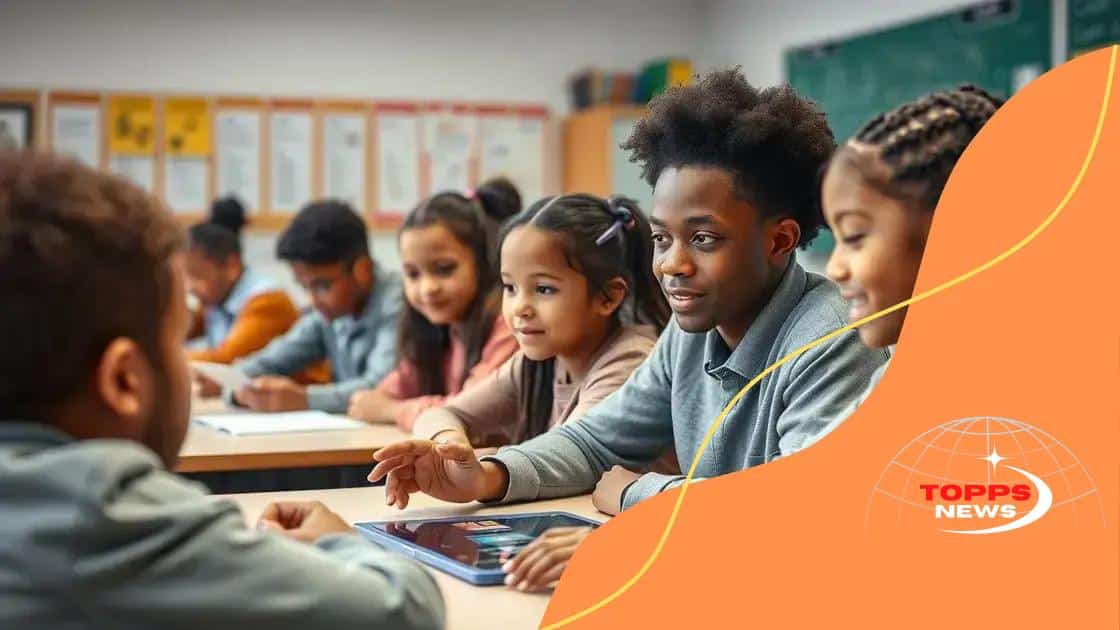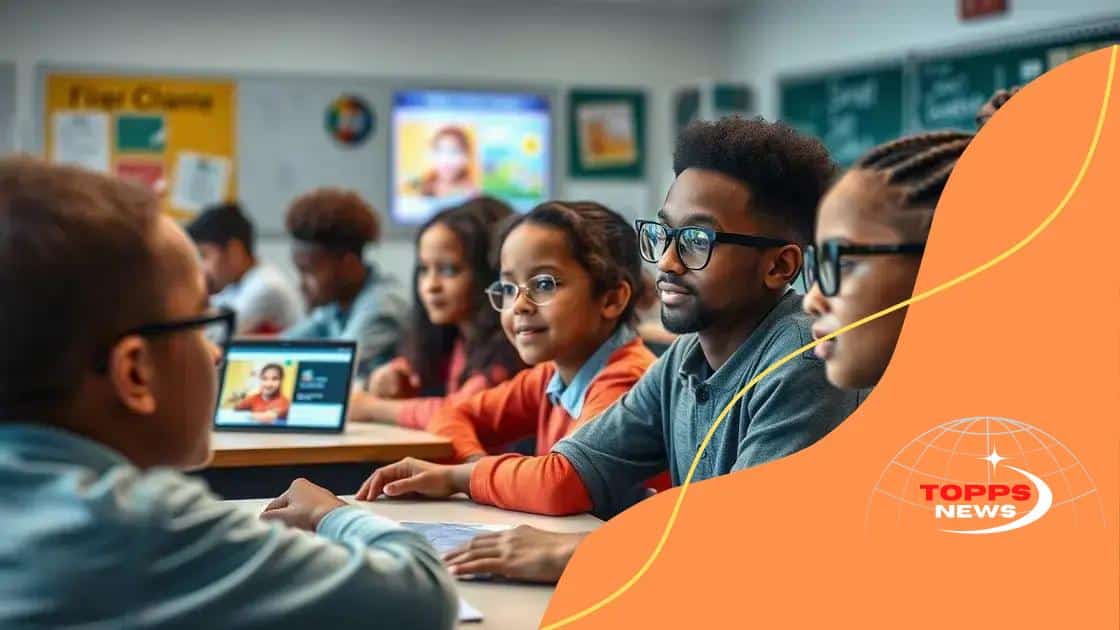AI support for special education: enhancing learning experiences

AI support for special education enhances learning by personalizing experiences, utilizing data analysis for tailored teaching strategies, and integrating technologies like virtual reality to engage diverse learners effectively.
AI support for special education is changing the landscape of learning for many students. Have you ever wondered how technology can make a difference in the classroom? Let’s explore this together.
Understanding AI in special education
Understanding AI in special education is essential as technology reshapes the classroom. Many teachers and students benefit from how artificial intelligence can make learning more accessible and effective. Let’s look at how AI can enhance education for students with special needs.
The Role of AI
AI plays a pivotal role in identifying and meeting the unique needs of each student. Tools powered by AI can analyze student performance and adapt instructional methods accordingly. This adaptability allows for personalized education plans tailored to individual learning styles.
Key Benefits of AI in the Classroom
- Personalized learning experiences for diverse learners.
- Real-time feedback on student progress to inform instruction.
- Automated administrative tasks, freeing up educators for direct interaction.
These benefits not only enhance the learning experience but also help educators focus more on teaching rather than administrative duties. For instance, algorithms can help identify where students struggle and suggest resources or strategies to assist them.
Moreover, AI tools can facilitate communication and collaboration among students with different abilities. For example, software that converts text to speech can assist students who have difficulty reading. This access to technology ensures all students can participate fully in classroom activities.
Challenges and Considerations
While the advantages are clear, it’s also important to consider the challenges. Schools must invest in appropriate infrastructure and training, ensuring that teachers are equipped to use AI tools effectively. A careful approach can meld technology and human touch for best outcomes.
Benefits of AI tools for teachers
The benefits of AI tools for teachers are becoming increasingly clear, especially as classrooms evolve to embrace technology. These tools help educators in various ways, streamlining their workload and enhancing the learning experience for students.
Improved Efficiency
AI tools automate many time-consuming tasks. With features like grade assessments and tracking student attendance, teachers have more time to focus on teaching. This means more lesson planning and better student engagement.
Personalized Learning
One of the most significant advantages of AI is its ability to tailor learning experiences. For example, AI platforms can assess a student’s strengths and weaknesses, adjusting lessons to meet individual needs. This personalization helps students learn at their own pace.
- Identifies areas needing improvement.
- Provides resources based on student performance.
- Encourages self-paced learning.
By incorporating AI, teachers can create an environment that supports diverse learning styles, allowing every student to thrive. The result is a more inclusive classroom where all students have the opportunity to excel.
Enhanced Communication
AI also facilitates better communication between teachers, students, and parents. Through tools like chatbots and messaging systems, teachers can keep families updated on their child’s progress effectively. This open communication fosters a supportive community around each student.
Additionally, AI tools can help teachers gather data over time, enabling them to identify trends in student performance. Such insights can lead to more informed decisions in instructional methods, further benefiting the classroom environment.
How AI tailors learning for students

AI has the remarkable ability to tailor learning experiences for students, ensuring that education meets individual needs. This personalization is crucial for enhancing student outcomes, especially for those with unique learning challenges.
Adaptive Learning Technologies
One significant way AI achieves this is through adaptive learning technologies. These systems analyze student performance in real-time, adjusting the curriculum accordingly. This means that lessons can become easier or more challenging based on how well a student is grasping the material.
- Immediate feedback helps students improve quickly.
- Customizable content addresses different learning styles.
- Engagement increases as students learn at their own pace.
With these technologies, each student can have a learning path designed just for them. This is especially helpful in special education settings, where individual progress varies greatly among students.
Data-Driven Insights
Data plays a key role in how AI tailors learning. By collecting information on student performance, AI can identify patterns that human instructors might miss. For instance, if a student struggles with specific math concepts, AI can recommend targeted exercises to strengthen those skills.
This approach not only helps students improve in areas where they struggle but also encourages mastery of essential skills before moving on to more challenging topics. The focus on data-driven insights supports a more effective learning experience overall.
As AI continues to evolve, the potential for enhancing personalized education grows even more. Teachers can leverage these tools to create dynamic and responsive learning environments that cater to diverse student needs.
Real-world applications of AI in classrooms
Real-world applications of AI in classrooms are transforming education, making learning more engaging and effective. From personalized tutoring to administrative support, AI is changing how students learn and teachers teach.
Intelligent Tutoring Systems
Intelligent tutoring systems are among the most impressive uses of AI. These programs provide personalized instruction and feedback, helping students understand complex subjects at their own pace. For example, platforms like Khan Academy use AI to adapt lessons based on a student’s progress.
- Identifies students’ strengths and weaknesses.
- Offers tailored resources and exercises.
- Tracks progress over time to improve learning outcomes.
This individualized approach boosts confidence and mastery of subjects, leading to better results in the classroom.
Data Analysis for Teaching Strategies
AI can also assist teachers by analyzing data to inform teaching strategies. By examining student performance, AI identifies which teaching methods work best. This information allows educators to adjust their lessons effectively.
Moreover, using data analytics helps in predicting student outcomes. Knowing which students might struggle enables early intervention, leading to greater support where needed.
In addition, AI tools such as virtual assistants can answer routine questions, allowing teachers to spend more time interacting with students. These applications not only make classrooms more efficient but also enrich the learning experience.
Future trends of AI in special education
The future trends of AI in special education look promising, as technology continues to evolve and improve learning experiences for diverse learners. These advancements aim to create a more inclusive and effective educational environment for all students.
Enhanced Personalization
One significant trend is the use of AI to provide even greater levels of personalization. Emerging technologies will likely enable tailored learning experiences that adapt in real-time to each student’s needs, further enhancing their learning journey.
- AI can analyze student behavior and learning patterns.
- Customized resources will be available as students progress.
- Students will receive instant feedback, which will boost motivation.
This level of personalization is crucial for students with special needs, as it allows them to engage with material at a pace that suits them.
Integration of Virtual and Augmented Reality
Another exciting trend is the integration of AI with virtual and augmented reality (AR/VR). These technologies create immersive learning experiences that can bring lessons to life.
Students can engage in hands-on activities in safe environments that simulate real-world scenarios. This approach helps students develop practical skills while benefiting from the unique advantages of AR and VR, like overcoming sensory challenges.
Predictive Analytics for Early Intervention
The use of predictive analytics will become more prominent, allowing educators to identify students at risk of falling behind. By analyzing data from assessments and classroom interactions, AI can help teachers identify trends.
This proactive approach will enable early interventions, ensuring that students receive the support they need before challenges escalate. AI algorithms will play crucial roles in optimizing teaching strategies and overall classroom dynamics.
FAQ – Frequently Asked Questions about AI in Special Education
How can AI personalize learning for students with special needs?
AI can analyze each student’s strengths and weaknesses, creating customized learning experiences that adapt in real-time to their needs.
What are some examples of AI tools used in special education?
Examples include intelligent tutoring systems, adaptive learning platforms, and communication aids like speech-to-text tools.
How does data analysis benefit teachers in the classroom?
Data analysis allows teachers to identify trends in student performance, enabling early intervention and tailored support for each student.
What future trends can we expect from AI in special education?
Future trends include enhanced personalization, integration of virtual reality, and predictive analytics for early intervention.





